Dufferin’s New Landlord
With its purchase of the mega quarry lands, a Canadian investment firm gained control of one of the biggest single blocks of prime farmland in Ontario. Will the new landlord be better than the old?
On the prime potato-growing soil of Melancthon Township, this spring marks a new beginning – in more ways than one.
When The Highland Companies announced in November 2012 that it was withdrawing its application to build a 2,316-acre quarry here, many celebrated the news as an interim victory – “interim” because they wondered what was in store for the vast lands that Highland had accumulated, and what would be done with the valuable limestone that lies below and had attracted the company’s attention in the first place.
Then, in July 2013, came news that Highland had sold its sprawling Melancthon holdings – about 6,500 acres in all, representing nearly half of Ontario’s largest contiguous block of prime vegetable-growing land – to Bonnefield Financial Inc., a Toronto-based farmland investment firm that owns more than 40,000 acres across Canada. The sale was trumpeted as “one of the largest farmland transactions in Canadian history.”
Local residents, understandably suspicious of yet another investment company buying up land in the area, waited for the other shoe to drop. After all, Highland had made its first purchases in 2006 and had taken nearly three years to fully reveal its quarry plans.
Bonnefield’s intentions, however, seem pure. The company’s stated goal – “to preserve farmland for farming” – seems to signal a happy ending to the famous fight to stop the mega quarry.
Yet with the transition to Bonnefield’s ownership still in the works, much remains to be seen about how the details will play out. Melancthon is trading one profit-driven corporate owner for another. The fact remains that Highland’s purchase of these lands means their fate will be forevermore controlled by global market forces and outside interests, reflecting changes in agriculture not only here, but also across Canada and worldwide.
Some view the changes as a step forward in competitive efficiency, while others lament the end of the family farm.
![If [farmers] can secure stable long-term leases to farm that same land, they can continue operating without tying up all their assets in land ownership, giving them much needed money to pay debt or invest in equipment. Photo by Donna Wells.](https://www.inthehills.ca/wp-content/uploads/2014/03/quarryland_PotatoFactory.jpg)
If [farmers] can secure stable long-term leases to farm that same land, they can continue operating without tying up all their assets in land ownership, giving them much needed money to pay debt or invest in equipment. Photo by Donna Wells.
Fields of Gold
In 2008, Bonnefield president Tom Eisenhauer was a Bay Street executive who had just sold his tech financing firm and was looking for new forms of investment. “[Tech financing] was a lot of fun, but it’s a white-knuckle business,” he says. “I was just looking from an investment perspective for assets that are less volatile.”
Eisenhauer started looking at farms near his wife’s family home in southwestern Ontario as a personal investment. Along the way he became convinced that farmland represented a larger business opportunity.

Tom Eisenhauer, president of Bonnefield Financial Inc., says that unlike hedge fund investors, his company’s investors are looking for the kind of steady, long-term returns more typical of farmland. Photo by Pete Paterson.
“The average farmland appreciation rate in Canada is 7 or 8 per cent over 60 years. That kind of return with a low volatility asset sounds like a good idea to me,” Eisenhauer says. Bonnefield’s investor information says that farmland returns have beaten stock market gains over periods of 10 years or longer. In the nearly 60 years from 1951 to 2010, for example, the value of farmland in Canada declined in just seven years, while the value of stocks fell in 15.
Eisenhauer isn’t the only one to have discovered this. Farmland is what American financier Warren Buffett calls a “productive asset.” Others call it “gold with a coupon” because, like gold, it’s a hedge against inflation and financial market downturns, while paying a dividend in the form of rent.
After the subprime mortgage crisis of 2007–08, global investment capital piled into the relatively stable agricultural sector, buying up ten times as much farmland (about 111 million acres) in 2009 as in previous years.
“The long-term fundamentals for Canadian agriculture – with population growing, and diets changing in the Third World, and climate change making it harder for the traditional parts of the world to produce as much as they’ve produced historically – all those trends suggest a huge advantage in the future to Canadian farms and Canadian farmers,” says Eisenhauer.
In one of his investor presentations, Eisenhauer points out that Canada is sitting on 9 per cent of the world’s fresh water, and rainfall in this country is increasing at a time of projected water scarcity elsewhere. He also cites a 2011 Science magazine study that found Canada is the only country in which climate change is increasing, rather than reducing, agricultural productivity. All this is happening as the United Nations predicts that, by 2050, the world will need to squeeze 70 per cent more food out of existing farmland.
Yet farmland in Canada remains comparatively cheap. For a variety of reasons, Canada has been slower to attract corporate investment in farmland than other countries, and provincial laws have put large swaths of agricultural land – all of Manitoba and Saskatchewan, for example – off-limits to foreigners.
In talks with farmers, Eisenhauer also learned they have a desperate need to access capital by selling their land. But if they can secure stable long-term leases to farm that same land, they can continue operating without tying up all their assets in land ownership, giving them much needed money to pay debt or invest in equipment.
Meanwhile, the farm population is aging. In 2011, 48 per cent of farmers in Canada were older than 55, and many are counting on funding their retirement by selling land. Eisenhauer told The Globe and Mail that Bonnefield estimated that as farmers retire over the next 10 to 15 years, about $53 billion worth of Canadian farmland is likely to change hands. This opens up enormous buying opportunities for investors.
So instead of buying a farm only for himself, Eisenhauer and his business partners started Bonnefield Financial in 2009 and began raising money to invest in farmland in a big way.
In 2012, Bonnefield briefly announced, but then withdrew, an initial public offering on the Toronto Stock Exchange. The move would have allowed small investors and foreigners to buy shares, but the company elected instead to continue seeking money privately through “high net worth accredited investors and institutions.”
Bonnefield accepts a minimum investment of $150,000, and most of its funding comes from large Canadian pension funds, which in recent years have hopped on the farmland investment trend. The Canada Pension Plan Investment Board, for example, launched an agricultural investment program and, earlier this year, spent $128 million to buy out Assiniboia Farmland LP, a farmland investment fund holding 115,000 acres in Saskatchewan.
Bonnefield’s early investments are already paying off. The value of its first limited partnership, a $26.6 million fund that invested in 15,000 acres of farmland, increased 61.29 per cent in its first three years, an annualized gain of 15.82 per cent. This meant that it significantly outperformed stocks over the same period.
By this past January, Bonnefield had established three farmland funds, raising more than $320 million from Canadian investors, both individual and institutional. About $260 million of this total came from its most recently created fund, Canadian Farmland Limited Partnership III, suggesting the company’s business model is gaining traction.
And this is how Bonnefield found itself sitting with multimillions ready to invest when Highland nixed its quarry plans. Eisenhauer, whose Stop the Mega Quarry lawn sign now sits in his Bay Street office, says he “smelled a rat” when Highland professed a long-term interest in farming, so he had a hunch the company would be receptive to the idea of a quick sale.
“I have yet to meet the hedge fund manager who’s interested in farming,” he says. “It’s not a high enough return for them. Those guys are looking to knock the ball out of the park and make ten times the money, and you’re not going to do that in the farming business. Farming is all about steady returns, not huge massive returns.”
As a result, Eisenhauer told Wei Chen of CBC’s Ontario Morning, “I reached out to the Highland Group and said, ‘Look, if you really don’t have a long-term interest in farming these lands, maybe there’s an opportunity here for us to help you out.’”
Under New Management
Bonnefield paid the Highland Companies “more than $50 million, a lot of money” for the land, says Eisenhauer. This would put the purchase price in the range of at least the $8,000 an acre that Highland reportedly paid in 2006 and 2007, and is in line with the current rate of $8,500 to $10,000 an acre for prime farmland.
Most of Bonnefield’s previous land purchases have been sale leasebacks. Under these arrangements, farmers sell their property to Bonnefield to free up some cash and immediately sign a long-term lease to continue farming the same land. “We like to know who the farmer’s going to be in the long term and to look at their farming practices and get comfortable with them,” says Eisenhauer.
So for Bonnefield, taking on 6,500 acres with no long-term tenant was uncharted territory. The company solved this problem by temporarily leasing the land back to Highland so it could finish out last year’s growing season, leaving Bonnefield the fall and winter to find long-term tenants.
Bonnefield also had to take stock of a mishmash of new assets, including some 25 houses in various states of disrepair, vacant residential lots whose buildings had been razed in preparation for the quarry and 30-odd farm buildings, including potato storage and processing facilities.
Because Bonnefield’s sole interest is farmland, the company set out to sell off as many buildings as it could. It also started introducing itself to the community and consulting with local stakeholders in a way that has earned quite a bit of community goodwill. Highland-owned potatoes are still in storage and Highland employees still live in some of Bonnefield’s houses, but those leases will expire this summer and new owners will take over. It’s “the light at the end of the tunnel,” says one Highland employee.
The community feeling is one of relief, says Melancthon mayor Bill Hill. “We aren’t naive enough to forget that the resource is still in the ground. But I think the way that Bonnefield is doing it makes the chances of a mega quarry certainly reduced. Tom Eisenhauer made a delegation at our request to council so they could publicly go on the record and outline what their plans were. Everything they said they’d do they seem to be doing and at this point in time we’re quite happy with them.”
Bonnefield approached NDACT – the North Dufferin Agricultural and Community Taskforce originally set up to oppose Highland – which urged the company to sell the houses and vacant lots to builders to attract people back to the community. “There was very quick agreement there,” says NDACT chair Carl Cosack.
Bonnefield quickly sold some houses to three local developers. Two houses went to Shelburne lawyer Wade Mills and contractor Dave Clarke, who started a company, Farm Lane Properties, to fix up and resell houses from the Highland sale.
“We saw this as an opportunity not only to create a business but also to rebuild the community,” says Mills, who expects more houses to be on the block shortly.
Bonnefield, NDACT and Melancthon council are also urging the Ministry of Rural Affairs to approve rebuilding some of the 33 farmsteads Highland tore down, and NDACT hopes at least half of these will be restored.
So far, restoring homes and encouraging families to move back into an area that had started to feel desolate – one local resident described it as “like Saskatchewan” – is the most noticeable effect of Bonnefield’s ownership.
But the revitalization is also a sign that Bonnefield is acting in good faith. The company is restoring a social fabric the Highland activity was destroying – and every new homeowner is an additional potential vote against a future quarry. “They’ll be new owners and new members of our community, and more tax revenue,” says Hill. “That’s a good news story.”
NDACT is even working with Bonnefield to re-establish the natural wind breaks Highland had removed, and Cosack says the company has been “very accommodating” and “truly engaged.” He adds, “We’re truly grateful that Canadian money is back in this country. So far they have given us no reason to doubt their intentions. It’s good to work with them.”
Grow Big or Stay Home
So far, the only complaint against Bonnefield’s tenure is that the land seems to have slipped permanently out of the hands of small farmers or those with a style other than what Bonnefield describes as “progressive, profit-oriented.”
One local farmer who was trying to lease land from Bonnefield and didn’t want to be named said, “I’m not sure there aren’t farmers in the area who could have bought [the land], but [Bonnefield] got the whole of it all. No other chance was available.”
After selling many of the buildings and a couple of smaller parcels, Bonnefield was left with about 5,500 tillable acres. Last fall, the company proudly billed these holdings as “Dufferin County Farms” and issued a call for farmers to submit written proposals for leasing land in “one of the largest contiguous packages of Class 1 farmland in Ontario.”
About 25 applicants submitted proposals for working the precious Class 1 Honeywood silt loam. In addition to solid finances, successful applicants were required to exhibit “strong operating records, excellent land stewardship, and a robust plan for future growth and profitability.” The company narrowed the applications down to five local farmers who would work an average of about 1,000 acres apiece.
“We had hoped that smaller farmers would get a chance at some of the leased land, but in the process that didn’t seem to happen,” says Cosack. “We struggled with that, but business is business.”
Bill French, a vegetable grower who farms about 450 acres on County Road 124 in the heart of the quarry lands, is one smaller farmer who didn’t make the cut. “Us little guys that wanted to rent one farm [100 or 200 acres] didn’t get a chance at it,” says French. “And I don’t know if I would have paid that much rent anyway.”
French says Bonnefield wanted a basic annual rent of $330 an acre, a figure in keeping with the company’s goal of earning a 3 to 4 per cent return on its investment. But tacked on to this basic rate was an additional per-acre fee to cover taxes and so on. And when French found that the company would allow vegetables to be grown on the land only every third year, he thought he would lose money.
So when a nearby 93-acre parcel came up for sale, French decided that it made more sense to spend about $8,500 an acre to buy the land. According to his calculations, the interest payments on his mortgage for the new property amount to roughly what he would have paid Bonnefield to rent a similar-sized acreage, and the purchase means his equity in the parcel will grow with every mortgage payment. He acknowledges that other farmers might do the math differently – and they clearly did, as Bonnefield seems to have found its tenants.
Still, French is pleased enough with Bonnefield as a neighbour. “I had a talk with them and they seem all right,” he says. “With Highland, you never knew where you stood. The stories kept changing. There was just something fishy going on from day one, whereas I don’t have that feeling from Bonnefield.”
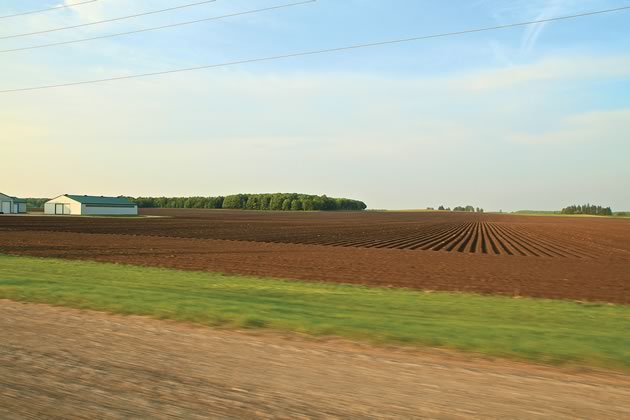
Bonnefield approached NDACT – the North Dufferin Agricultural and Community Taskforce originally set up to oppose Highland – which urged the company to sell the houses and vacant lots to builders to attract people back to the community. Photo by Donna Wells.
The shift in land ownership and tenancy to larger farms reflects the same macroeconomic trends that enabled John Lowndes and The Highland Companies to buy up so much land in the first place. To remain profitable, farms are being forced to grow bigger, and not enough farmers have the money to buy out the growing numbers who are retiring.
Between 1991 and 2011 the size of the average farm in Canada increased by 30 per cent. David Sparling, a business professor and agri-food policy expert at Western University’s Ivey Business School, has spoken at Bonnefield conferences and has found that, to be profitable, most farms must achieve at least $250,000 in annual sales. And for the first time in history, more than half the sales generated by Canadian farms now come from farms with total sales of a million dollars or more.
“As farming continues to become bigger business, it will have to shift away from the old model of farmers owning all of the land to one where they can lease,” says Sparling. About 40 per cent of Canadian farmland is currently leased, and this is nothing new, he adds. But in the past, land was usually rented from retired farmers or other individuals or investors who owned some farmland. “Bonnefield is just a more organized and systematic approach.”
Bonnefield has reassured the community it isn’t just another big corporation out to make a quick buck. Its rental rates are set to earn an annual dividend of 3 to 4 percent on its investment. This, as well as the appreciation of the land’s appraised value, is how the company calculates returns.
Aggregate mining and other forms of development aside from farming do not figure into Bonnefield’s calculations, says Eisenhauer. Nor does flipping the land to realize paper gains in the short term. As for wind power development? “It’s my belief that the practical likelihood is nil,” he says. “It would be a brave, brave wind developer who tried to set foot in that community again.”
Eisenhauer is adamant that Bonnefield’s big institutional investors are in for the long haul – “minimum 20 years” – with all the patience in the world to reap the benefits of farmland’s steady payoff.
Bonnefield’s arrival certainly seems to be a win for area farmers, especially those large and “progressive, profit-oriented” enough to benefit from leasing. For smaller operators like Bill French and his neighbour Ralph Armstrong, who continue to own all the land they farm, it may be enough to know that the surrounding fields won’t be blasted into a quarry, threatening their well water and their peaceful way of life.
Armstrong, 72, raises livestock on 200 acres in much the same way as five generations of his family have since settling here in 1853. He fought hard against the quarry but now views the Bonnefield regime and the changes it represents with equanimity.
“A few generations ago we came over here so we could own the land ourselves,” he says. “Now we’re going back to where the moneyed people are going to own the land and farmers are just going to work the land. It’s just like nobody can build a car by themselves. It’s got to be a corporation doing it. Agriculture is getting to be the same way.”
More Info
How Investors Care for the Land
Bonnefield Financial shows every intention of being an excellent farmland steward. The company’s rental agreements allow farmers to use the land “as if owned,” giving them independence and the stability of a rolling five-year term that adds a year to the end of the lease after each successful year – unless the farmer opts out.
Bonnefield president Tom Eisenhauer says the company asks just two things of tenants: pay the rent and adhere to the company’s standards of care, a sort of “farming best practices code” designed to ensure the land remains productive in the long term.
Motivated by Bonnefield’s hard-nosed concern for preserving the value of the land, the standards of care are a welcome reassurance that the company’s long-term interest matches its motto: “Farmland for farming.” Here is a rundown of the standards:
- crops Farmers must provide Bonnefield with a rolling five-year crop, fertilizer and pesticide plan using the input of a professional crop adviser. To maintain soil productivity and to minimize soil pesticide residues and resistant pest infestations, crops must be rotated every two or three years.
- pesticides Every year farmers must provide Bonnefield with a list of all pesticides applied, as well as a proposed pesticide-use plan.
- water Buffer strips from surface water must be maintained. Fields near watercourses must be maintained and drainage systems kept unobstructed.
- soil Soil erosion must be minimized through good tillage practices and main- tenance of existing watercourses and drainage areas. Farmers must ensure that soil is tested every three years and manage soil inputs according to the results.
- trees Farmers must not cut trees for the purpose of sale or personal use.
- noise Farming operations must not cause “undue noise or other nuisance.”
Learn More
Tom Eisenhauer, president of Bonnefield Financial, and Steve Peters, executive director of the Alliance of Ontario Food Producers, will be featured speakers at a public meeting organized by the North Dufferin Agricultural and Community Taskforce and Food and Water First. The meeting takes place at 9:30 a.m. on Saturday, April 5, in the Town and Country Room of the Centre Dufferin Recreation Complex, 200 Fiddlepark Lane, Shelburne. Because space is limited, those who wish to attend are advised to register and reserve spots at www.ndact.com.
Related Stories
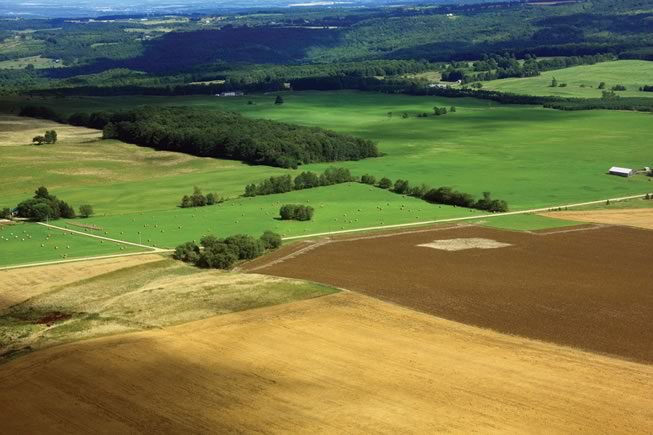
Birth of a Protest
Jun 16, 2011 | | EnvironmentThis spring, when The Highland Companies filed its application for a 2,316-acre limestone quarry, a small rural protest caught the big wave.
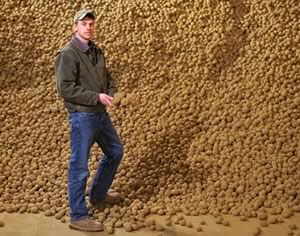
High Stakes in the High County
Sep 16, 2009 | | EnvironmentThe Highland Companies, a U.S.-based investment syndicate, has assembled 9,500 acres, most of it in Melancthon, but many people in the community, led by NDACT, worry about the future of their farmland and water resources.



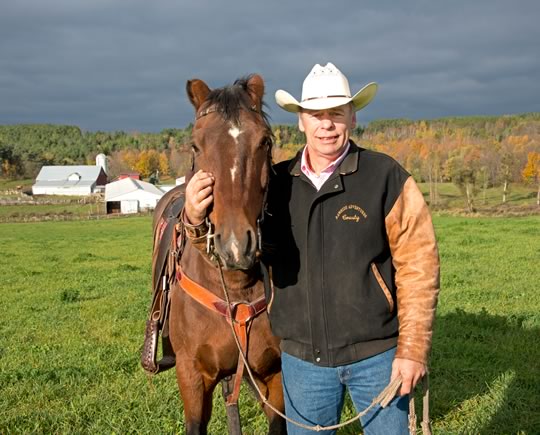
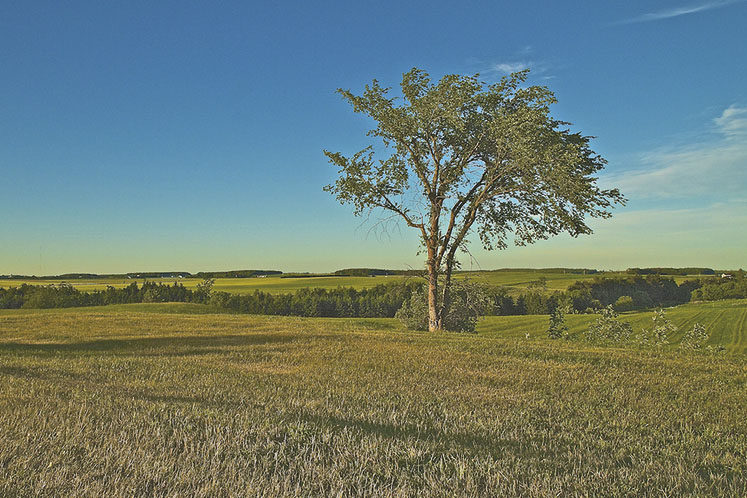





Congratulations to Tom Eisenhauer for acquiring this wonderfully water rich farmland and preserving the proud history of Honeywood/Mulmur and its rich surrounding water table.
Formerly Ontario’s only Arctic Char farm founder (just south of Honeywood) my father and I experienced first hand the profligate 1000 liters per minute nourishing cold springs. Then were cleansed by nature and meandering across North West Mulmur. Proximity to market, capital investment for safe and expensive farm equipment will bring employment and needed income
for entrepreneurial Melancthon residents and Dufferin County.
As a 50 year former Mulmur Farmer of FallingBrook Springs I congratulate “In The Hills” for their courageous achievement in farmland preservation.
Dr Peter Benedict P.Eng, Ph.D, E.E., Inventor, VE3PB
Founder: The Technology Group of Companies
Dr Peter Benedict from Muskoka, Toronto and Mulmer for 50 years on Apr 18, 2014 at 4:51 pm |
Thank you for this informative article. I ws not able to attend the meeting in Shelburne today (April 5), and this gives me much of the news I have been long anticipating to hear about the future of the former Highlands’ lands within our community. While I still have some concerns, I will say that the greatest ones I have held around the safety of our water and the division of our community have softened into relief.
Shelley Hannah from Wasaga Beach, formerly Mulmur on Apr 5, 2014 at 11:05 am |